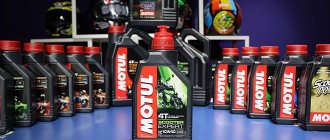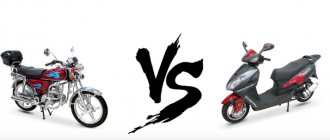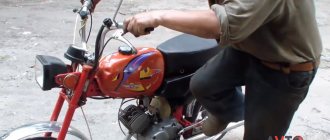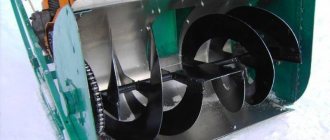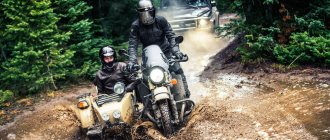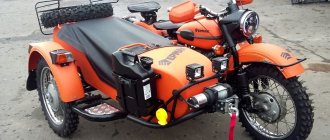What is the ideal dirt bike? The answer to this question depends only on you, since all bikers have different wishes, requirements, financial capabilities and tastes. Some people prefer a universal bike for the city and rough terrain, some want a real all-terrain vehicle, that is, a motorcycle with wide wheels, while others prefer to squeeze out huge doses of adrenaline on a compact pit bike with a mean little engine. Not every off-road motorcycle is equally good for different purposes; some are more versatile, while others are designed exclusively for sport. You wouldn't drive a rally car to work, right? In the case of two-wheeled vehicles, this principle also works one hundred percent, and many off-road motorcycles are not suitable for everyday use.
Off-road scooter: difference from conventional equipment
Off-road scooters, which, according to manufacturers, can travel hundreds of kilometers on unpaved roads, must have the following parameters:
- larger wheel diameter compared to conventional scooters;
- wide tires with powerful tread.
The ground clearance will directly depend on the diameter of the wheel. If regular mopeds have a wheel diameter of 25 cm, then for off-road scooters it ranges from 30 cm or more. As practice shows, high ground clearance, which appeared due to an increase in the diameter of the wheels, allows the driver to feel comfortable even when driving over medium-height bumps.
Unpretentious wide tires with a powerful tread will allow you to drive through mud and clay without getting stuck in it. We should talk in more detail about other differences between off-road mopeds.
The main thing is in the details
Off-road scooters also have other, more serious, design features.
- The front fork should dampen some of the vibrations that occur when driving off-road. That is why it will be better if it is pendulum rather than the usual telescopic one.
- The air intake filter should be located as high as possible, since there is a high probability that the scooter will simply stall after passing through a puddle.
- On a high-quality off-road scooter, the muffler is located quite high, and it is protected by an additional casing.
- The power and engine capacity of a moped intended for driving on country roads should be greater than that of equipment for city travel.
Soviet motorcycles
Various bikes were produced in the USSR, but mostly they were equipped with larger engines. Soviet motorcycles with an engine capacity of 125 cc are very poorly represented; only Minsky, Moskva and a few mopeds come to mind. "Voskhod" and "ZiD" already had engines from 175 cc. see above, “Planets” and “Jupiters” were even more powerful, but there is nothing to say about the “Urals” and “Dneprs”. However, in the USSR, before the collapse of the state, they at least produced their own motorcycles, but now almost all companies only assemble small-capacity motorcycles from Chinese components.
Which is better: two-stroke or four-stroke internal combustion engine
When choosing this vehicle, the first thing you should pay attention to is the structure of the engine. It comes in two types: two-stroke and four-stroke. Recently, most scooters have been produced with a four-stroke internal combustion engine. Such machines are characterized by reduced consumption, quiet operation, and ease of operation. Also, such devices have an increased level of environmental friendliness. But they have one significant drawback that repels buyers - high cost of maintenance.
Two-stroke engines are unpretentious to fuel and operating conditions. Such scooters pick up speed faster, that is, they have increased unit power. In addition, they are much cheaper than mopeds with a 4-stroke internal combustion engine.
Cons of a two-stroke engine
The disadvantages of two-stroke internal combustion engines include:
increased fuel consumption;
increased noise level;
unnecessary hassle when refueling (gasoline must be mixed with engine oil);
a large amount of exhaust gases.
Sportbikes
Sport goes hand in hand with power, and this is an indisputable fact. Therefore, 125 cc sportbikes seem to exist, but in reality most of them are ordinary small-capacity bikes, slightly stylized as racing equipment. They don’t have enough horsepower to qualify as full-fledged sports motorcycles, and not enough torque either, and this is true to one degree or another even for many entry-level Japanese bikes. The products of Italian brands, for example, Aprilia, stand somewhat apart. The Aprilia RS range includes small 2-stroke sportbikes that are truly fast and arguably the best in their class. The same RS125 is capable of reaching a maximum speed of 140 km/h! But the price for such impressive technical characteristics is the low resource of the forced engine.
What are the most reliable scooters: what to look for
It is necessary to approach the choice of an “iron horse” with special responsibility. After all, by purchasing a low-quality product, you risk harming not only your health, but also the health of the people around you. In addition, riding a poorly assembled moped will not bring you proper pleasure.
The motor is the first thing you need to pay attention to. After all, almost everything depends on the choice of the type of internal combustion engine: from the durability of the device to its behavior on the road in dense traffic.
Power is also an important indicator, on which not only speed, but also the level of its maneuverability depends.
Manufacturer. A brand is an indicator of the quality of parts and their assembly. Well-known bike brands closely monitor each assembled unit, so defects in their products are extremely rare. It often depends on the manufacturer whether you will use the equipment for a long time, or whether in a month you will put it in the garage or sell it for spare parts.
Consumables and spare parts. High-quality and more expensive consumables and spare parts guarantee a long service life.
Which scooter or moped is better for an adult to buy – Japanese or Chinese?
It is believed that the best motorbikes are new ones, and it does not matter in which country they were made. But many people will disagree with this statement. After all, a certain stereotype has long been established in the minds of Russians, according to which goods produced in China do not differ in special quality indicators.
Products from Japan are famous for their high reliability indicators. But there is a certain disadvantage - they are quite expensive. If we compare the products of these two countries, a new moped from China will cost about the same as a used Japanese one. Therefore, in this situation, the choice remains solely with the buyer: if he is 100% confident in the serviceability of the Japanese used vehicle, then naturally the choice is obvious. Otherwise, it is best to take a Chinese one. As for repairs, it will be much cheaper for you to fix the latter.
Pitbikes
These mini motorcycles are not made for lazy rides, but for fun. Don't be fooled by their modest size and small engine capacity - pit bikes are capable of a lot! This class is very diverse, it can include both an off-road moped with a 50 cc engine, and an evil little monster with a 2-stroke engine of 35-40 hp. Such motorcycles are not allowed to drive on roads, but they are ideal as a moped for forests and other off-road conditions. Even a complete beginner can handle this lightweight motorcycle, especially if you don’t buy a model with a high-power engine.
Which Japanese scooter is better to buy?
There are three popular motorcycle manufacturers in Japan: Honda, Yamaha and Suzuki. The equipment of each of these brands has its positive and negative sides:
HONDA are relatively inexpensive and reliable vehicles that are not very fast on the road;
Yamaha is a popular brand of expensive bikes that can accelerate quickly and reach maximum speed;
Suzuki - scooters of this brand belong to the so-called “golden mean”. They are reliable and perfect for feeling confident in heavy traffic.
Which Chinese motorbike is better to choose?
Those who do not have the opportunity to buy an expensive unit from the land of the rising sun can choose a scooter from cheaper Chinese products. But it is very unlikely that it will serve you for very long.
SYM is a fairly common technique. Among other brands, China is distinguished by its durability and level of reliability.
KEEWAY is an inexpensive representative of the Chinese motorcycle industry. The key to long-term operation lies in choosing good fuel.
Irbis is a bike with an aggressive, sporty design. Inexpensive to maintain.
Why you shouldn’t choose 2t mopeds from China
As mentioned above, Chinese bikes do not have a high level of build quality. Therefore, during their operation, mopedists constantly encounter problems. In addition, there are several factors that will constantly haunt you when using such products:
almost complete lack of engine thrust;
increased fuel consumption;
constant need to clean and replace spark plugs;
reduced overall resource of the internal combustion engine.
Which is better for off-roading: a scooter or a motorcycle?
The article is a kind of response to the comment given to me in my first post.
I found the topic interesting. And I decided to write more about it.
But first, a little note!
About the topic of “expertise” and whether it’s worth listening to me at all.
I've been riding motorcycles since 2011. Since 2013, I have been riding mostly solo touring bikes and civilian enduro bikes. If these words don’t mean anything to you, I’ll just show you this video
And this video
This is where I go. Yes, off-road and dirt come my way.
But I have much less experience with scooters. I've ridden a scooter twice in my life.
The first time I took my license, I then wanted to understand where to start with a bike or a scooter.
And the second time, when I had already bought the first bike and they let me compare my ebrik (Yamaha ybr 125) with the Chinese 140.
I won’t discuss what is generally better for on-road and off-road. Otherwise we risk mixing together trophy raids, rally raids, expeditions, utility and sports quads, jeeps and a bunch of everything else.
The answer will be a scooter or a motorcycle.
Whether you believe me or not is up to you to decide.
better to choose a motorcycle for off-roading.
. And that's why.
Reason 1. Mechanics.
Motorcycles have a manual transmission. Yes, there are ones with a machine gun and even with a robot. But such bikes are expensive, weigh over 200 kg, and are poorly suited for off-road use. .
We do not take into account exceptions such as the new Africa. It costs 15k euros. New. A used from 12k.
All scooters with a volume of 50 - 110 cc will have a CVT.
In the mud on a motorcycle, you just stick it in the right gear and crawl out. It's a matter of practice, there's nothing complicated here.
Reason 2. Chassis.
A motorcycle has better suspension than a scooter. Large wheels will allow you to steer better on the ground. And it’s easier to crawl over holes and bumps.
The ground clearance is higher on a motorcycle. Which will allow you to crawl over logs or dry ruts from trucks.
Large suspension travel allows you to drive faster, without fear of getting a shock absorber breakdown. Well, or they will simply work out the bumps better
Spoke wheels are stronger than cast wheels. Plus they are more repairable. For example, you may accidentally run into the remains of a concrete pillar that you missed in the tall grass. Bend the rim. But the inner chamber will not “bleed air”. And you will be able to calmly drive to the asphalt and tire shop, where they will roll a wheel for you and the bike will be as good as new.
The scooter has a tubeless tube. A dented rim will “deflate” your wheel.
Reason 3. Rubber.
On a motorcycle you can put evil checkered tires, like this one. And you won't get stuck in any puddles.
Yes, the scooter also has bad tires. But she often looks like this. This pattern is called a herringbone.
And according to experience, it is not suitable for serious mixing on the ground. And you can drive on dry or shallow sand with any tires.
And also a life hack. On motorcycles there is a hole for a “shoe”, also known as a “tow bar”. This is a thing that presses the inner tube to the rim. So that you can drive at a very low pressure of 0.2-0.3 atmospheres.
For what? Increase cross-country ability. The lower the tire pressure, the higher the contact patch with the road. The motor is more stable, and the rubber rows even better.
Various and controversial.
Regarding the space on the scooter, there is more of it in stock. The toilet, as the seat space is called, is a cool thing. Add a rear case or a flat floor under the steering wheel.
On the other hand, you can make a trunk, side frames and carry a bunch of things on a motorcycle. But you will have to do it yourself or buy it.
Mileage is also a controversial concept. I think you can travel 100 km on any scooter. And no more is needed. You won't be doing sports.
Speed is also not important. Yes, on a motorcycle you can go 50 or even 60 over potholes and bumps. But most likely you will crawl your 20 km/h.
Weight doesn't matter either. The motorcycle will not weigh more than 140kg. And the scooter is more than 100. Well, yes, the scooter is lighter, but the ability not to get stuck will come to you with experience.
Which motorcycle is better to choose?
You need a lightweight dual-purpose motorcycle that you can, if necessary, register and ride on asphalt.
I would recommend something at the level of yamaha tw225, suzuki van van 200, suzuki djebel 200, yamaha xt225 serrow
Of all, the freshest is van van. The rest are from 1995 - 2003.
All of these bikes are beginner friendly. Hardy. And with proper maintenance they will last for years.
You won't drive with full throttle. And most likely the maximum equipment will be a helmet. Therefore, 15-20 horses and 200 cubic meters of volume will be enough for you. Believe me, even if your weight is 100 kg, it’s enough.
Under no circumstances take a cross bike or hard enduro bike. You will definitely break something for yourself. Plus you will constantly pour money into them.
Don't take China. He's unpredictable. Yes, you may be lucky and you will ride without problems for many seasons. Or you may be unlucky and you catch the engine wedge at two thousand km.
Japan, if properly served, will not present any surprises. Just bring a mechanic with you when purchasing a motorcycle. He will tell you how much extra you will have to invest in used equipment. bike.
You don't need the same Honda xr250r. And Jebel 250 is not for you either. These are great motorcycles though. But again, for your own purposes. Don’t buy a motorcycle for growth - your priorities will change, sell it and buy another one.
I wouldn’t recommend a motorcycle of the level of a Yamaha ybr 125 or a similar road bike either. It's cool, but it's not designed for use on the ground.
Do not take a motorcycle heavier than 140 kg dry weight. For example, a 650th transalp with a weight of 200+. He can drive and whatnot. But you definitely won’t be able to do it there without minimal experience.
Don't forget about your equipment. Motorcyclists fall. Without experience, you fall more often. On the ground, they fall more often.
No experience + on the ground.. Well, you understand.
Knee protection costs $60 for China and $140 for a good mid-range one. To fix a broken knee, you will have to invest $1000 or more. And yet, a knee is broken once, but it takes a lifetime to repair.
Here's an example again. I just went too far with the gas, I fell out of the blue
Instead of a conclusion.
This is my personal subjective opinion. I did not specifically consider the issues of height, weight, budget, and much more.
If you have anything to add, please feel free to comment.
If you have any questions, ask in the comments.
All-terrain vehicles Tarus, Ataman, Scout, Master Pro and others - price, characteristics and reviews of all-wheel drive and rear-wheel drive motorcycles in our Master Techno catalog.
Two-wheeled all-terrain vehicles are divided according to the drive formula 2x1 and 2x2:
2x1 - These are rear-wheel drive motorcycles
all terrain. They are distinguished by lighter weight, better handling and dynamics. Compared to all-wheel drive vehicles, they are inferior in cross-country ability and the ability to overcome steep climbs.
The most popular in this segment of equipment are: Scout all-terrain vehicles produced by Izhevsk and Ataman motorcycles from the Leningrad manufacturer Lebedev Motors. Also recently an interesting device SR-21 (S - Snezhny R - Region 21 - 2 wheels, 1 drive) from the Vyatka manufacturer known to us for Albatross motorized towing vehicles has appeared on sale.
All-terrain vehicles differ from standard motorcycles (Pitbikes, Cross, Enduro) in having wider and lower wheels, which gives good stability, but much lower speed and types of installed engines:
- 1. Engine 152 QMJ
(Volume from 79-120 cc/cm) – familiar to us from the Chinese Alpha and Delta mopeds, the weakest in the line, but at the same time lightweight and coupled with a manual transmission, which eliminates the lack of power. Widely used on Scout all-terrain vehicles. - 2. Engine 168F-190F
(Volume from 200-460 cc/cm) – these are general purpose engines originally developed by Honda for installation on gas generators, walk-behind tractors, pumps, go-karts, etc. Despite the Chinese production, they have rightfully earned the reputation of reliable and indestructible engines. It is believed that this engine has only 2 breakdowns, due to which it may not start, it is either a flooded spark plug (due to the Transistor ignition system) or you simply run out of fuel in the tank. These are 2 things that you need to carry with you. And among the shortcomings we can also highlight the lack of a normal transmission. As a rule, this centrifugal clutch is dry or in an oil bath and is not particularly reliable. - 3. Engine 157-164 QMJ
(Volume from 150-180 cc/cm) – with a relatively small volume, this engine has a very perky temperament and is the most “disruptive” on all-terrain vehicles. These engines were developed by Honda specifically for installation on ATVs and motorcycles and, with a relatively small piston group volume, produce very high power from 9.5-12 hp. at 8000 rpm. This engine also comes with its own transmission, which is a gearbox (FNR) and a variator in a closed housing with asymmetrical cones. Among the disadvantages, we can note the rather large weight and complex electronics, which are not very good when operating an all-terrain vehicle in extreme conditions far from civilization.
2x2 - All-wheel drive all-terrain vehicles, BM, Tarus, Arhar, Pakhus, Siberia, Master Pro and others.
The founder of the genre is the American Rokon 2×2 all-terrain vehicle, which is positioned as a 2-wheeled tractor and a special services vehicle. For more than 50 years of its existence, the all-terrain vehicle has proven its reliability, practicality and is successfully used in military and industry organizations around the world. It was not widely used in Russia due to the high price and lack of spare parts.
All-terrain vehicle in a suitcase:
7 years ago in Russia there was an online video “All-terrain vehicle in a suitcase,” in which a very nimble and nimble vehicle drove through the most difficult conditions, then was quickly disassembled and put into the trunk of an Oka car. This was a prototype of the Tarus 2x2 all-terrain vehicle from Alexander Zinin. The inventor offered to buy drawings from him for self-assembly of an all-wheel drive motorcycle. But in reality, using these drawings in a garage without a Fraser, Laser, Bending Machines and other equipment, it was not possible to assemble such a motorcycle. One of the buyers of the drawings was Dmitry Bakhmetyev from the Krasnoyarsk region, who also failed to reproduce the high-tech device. And after a long correspondence with the designer, an extremely simplified all-terrain vehicle Siberia 2x2 was created, from which the derivatives Rusich 2x2, Shogrash, Master Pro and others were subsequently created.
These motorcycles are distinguished by very heavy handling and heavy weight, but at the same time they are reliable and unpretentious equipment for the most severe operating conditions. Alexander Zinin also launched the production of Tarus 2x2 motorcycles and even produced about 300 units, but subsequently abandoned production and went into another industry (Lawn mowers, tractors, etc.). A new player in the segment of all-wheel drive two-wheeled all-terrain vehicles ]Baltmotors moto BM 2×2[/anchor]. The product turned out to be of high quality, well thought out, and if the manufacturer does not raise the cost, then commercial success is guaranteed.
Our company is professionally engaged in the promotion, sale and support of any all-terrain vehicles made in Russia. If you are interested or have any questions, we are always happy to answer them.
